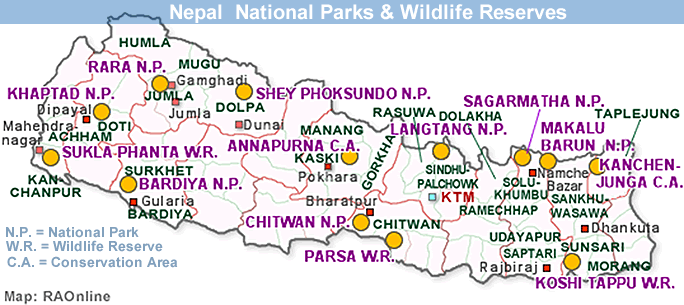 |
2006 |
|
 |
|
Bardiya's
rhinos and tigers in danger
|
 |
KATHMANDU,
Nepal, June 2006
 |
| The
recent political changes in Nepal that led to the ceasefire gave the Bardiya
National Park staff an opportunity to conduct a sweeping operation after
two years, supported by WWF Nepal, in the previously inaccessible Babai
valley between 21-24 May 2006, which revealed alarming signs of the decline
in rhino populations and possibly tiger numbers too, indicating widespread
poaching. |
|
A
40-member team on elephants led by Bardiya National Park was accompanied
by Dr Tirtha Man Maskey, Co-Chair of the IUCN Asian Rhino Specialist Group,
and Kanchan Thapa, Research Officer at WWF Nepal. Evidence of only three
rhinos was observed in the favourable rhino habitat in the southern part
of the valley. Since 1986, 83 rhinos have been translocated to Bardiya,
of which 72 were released in the Babai floodplain.
The
team apprehended two persons, one each from two different groups of poachers
(each group comprises more than 10 persons), armed with locally made muzzle
guns. Four weapons and a large cache of ammunitions were seized along with
more than 300 kgs of smoked Sambar, spotted deer, barking deer, and four-horned
antelope meat-all important prey species of the tiger and other carnivores.
This could have serious implications for the tiger population in Bardiya
National Park. In addition, all the guard posts inside the Babai valley
were destroyed during the conflict.
Thirteen
tigers were reported in the Babai Valley (1998-2001) and the team observed
the signs of 3 tigers during the operation. Furthermore, fewer than estimated
tigers were confirmed in a preliminary camera trap survey in the Karnali
floodplain of Bardiya National Park. The camera trap survey was started
in January 2006 and of a recorded tiger population of 18 in 2000-01, only
3 were camera trapped in the national park and 2 in the Khata corridor.
The latter is an important wildlife corridor between Bardiya in Nepal and
Katarniaghat Wildlife Sanctuary in India.
|
Department
of National Parks and Wildlife Conservation has initiated immediate steps |
 |
The
Department of National Parks and Wildlife Conservation, supported by WWF,
has already initiated a number of immediate steps: joint patrols by the
park staff and protection unit have been planned focusing on areas not
covered by the first sweeping operation and the buffer zone to verify the
findings. The continuing community-based anti-poaching operations are being
mobilized.
A
high level government fact-finding mission was dispatched by the Ministry
of Forests and Soil Conservation on 31 May 2006 to five regions including
Bardiya.
In
areas where the conflict had less impact on conservation work, rhino and
tiger populations are stable or growing. An August 2005 survey found that
the 11 rhinos released in 1986 in the Karnali River floodplain, also within
Bardiya National Park, had increased to more than 30. Tiger presence has
been recorded in the Khata corridor. The population of rhinos in the nearby
Shuklaphanta Wildlife Reserve is 7. None have been lost to poaching since
the translocation in 2000 and there has been an increase of three. The
ongoing tiger monitoring at Shuklaphanta estimates the population to be
around 27 adult breeding tigers.
"The
Babai case clearly shows the impact of conflict on conservation and WWF
is ready to increase its support in the efforts to address this threat,"
says Dr Chandra Gurung, Country Representative of WWF Nepal. "We call upon
all stakeholders to join hands at this critical juncture."
WWF
Nepal strongly urges the enactment of an immediate short- and long-term
plan for action on the ground.
| more
information |
 |
| 



